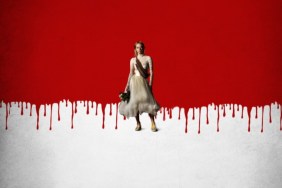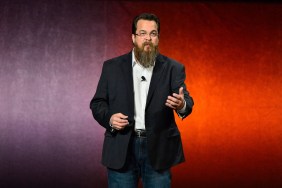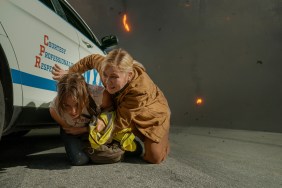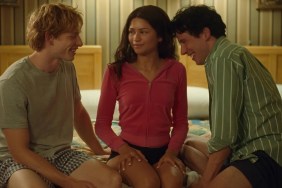
A collaboration between Mark Duplass and Patrick Brice (the latter directed), the film is considered a Blumhouse production, however, Duplass and Brice had been working on the film long before Jason Blum put his name on it.
In the film, Aaron (Brice) comes across a cryptic online ad: $1,000 for the day. Filming service. Discretion is appreciated. Low on cash and full of naiveté he drives to a cabin in a remote mountain town where he meets Josef (Duplass), his cinematic subject for the day. Josef is sincere and the project seems heartfelt, so Aaron begins to film. But as the day goes on, it becomes clear that Josef may not be who he says.
Shock spoke to Duplass and Brice (mostly Duplass) about their filmmaking process – it was an unconventional method for an unconventional thriller.
Ryan Turek: When we first heard of the film, it was entitled Peachfuzz. What prompted the title change?
Mark Duplass: Very specifically, if you call the film Peachfuzz, you spend the first half hour trying to figure out why the movie is called Peachfuzz and you can’t pay attention to the very intricate details. This is a very subtle, strange movie. If you call the movie Creep, you walk in knowing a little bit about what to expect. So, you shut that part of your brain off the macro and focus on the micro which is: Who is the creep and how creepy is this going to get? That was a big win for us.
Turek: How did you two partner for this project?
Duplass: We’re buddies. I saw Patrick’s documentary called Maurice, he follows this strange man who owns the last porn theater in Paris. And Patrick has a way of bringing things out in people and we love weird people. We’re always talking about people who have too much personal space with you or are a little over-sharing. We built the movie out of a series of conversations together. What if we put together an outline and start shooting this thing? We accepted it was going to be a mess and, basically, refine it while we’re shooting as opposed to refining it while we’re writing. It’s an arts and crafts project. [laughs] Which was very liberating and very fun. For a year and a half, we’d shoot, edit, show it to people, see what landed. Shoot, come back…it was really fun.
Brice: We diagnosed the problems. Did some reshooting and showed it to people, got a response.
Duplass: We’re very aware we’re trying to do something that’s a little bit challenging for an audience in terms of you can’t quite get your footing in this movie. And what’s what we like about it. In the theater, we watched everybody watching the movie and in a single moment some people in the same row would laugh and get scared at the same time. That’s interesting to me and we saw people arguing afterward outside of the theater. That’s exciting to us, this blend of – for lack of a better word – this Duplass brothers-style of filmmaking: Very relationship-oriented, very in-depth character study and the Blum world of filmmaking, a true genre juggernaut. What happens when we bring this together? I like the reactions that are all over the map. Some people were like, “We loved that you made it funny!” We didn’t decide to do that. We presented these characters. And others were surprised it was scary and we’re like, we just presented the scenario.
Turek: So, what is it to you two then? During the shooting process, were you intentionally steering it in certain directions? Were there alternate endings that demonstrated a different tone for the film?
Duplass: That would imply we shot a movie, edited it…I can’t stress enough, there were 10 to 12 permutations of each scene. It was a process in the making. To say there were alt endings, sure, there were several different ways this movie could have ended. We shot all of them.
Brice: There was a ripple effect for everything.
Turek: The Peachfuzz mask – how did you land on that werewolf visage?
Duplass: We did a lot of searching and talked about creating what it could be and then, eventually, we stumbled on this really obscure website and found the mask. We called up the guy and said we loved it.
Brice: The guy was a Rodney Dangerfield impersonator, actually. [laughs]
Turek: Where are you guys seeing the horror genre steering, I’m curious…
Duplass: My opinion on the horror genre is almost completely invalid because I don’t watch a ton of horror movies. If you want to see a movie like Creep it’s because you have two very relationship-oriented filmmakers, guided by Jason Blum, so what you’re going to get a movie that does not follow all of those rules of what a horror movie is. When Jason saw this, he told us, I’ve seen every piece of shit found footage horror movie, because I’m the guy they came to, but he liked we were not horror filmmakers, that we got the performances right, the relationship dynamics right. I think that’s what we’re bringing to the genre – in many ways we’re ignorant of it and we’re coming at it from a totally different angle.
Turek: The camera is mostly on you, it’s all on you, can you talk a bit about the process of this film for you?
Duplass: The role of Josef is a hybrid between my world of relationship movies and Jason Blum’s world of horror movie. If you think of a movie like Misery and what Kathy Bates did there, there’s something fascinating about that character. She’s sweet, there’s love there, but there’s a dark side. For me, what I modeled it after are people who are strong with their eye contact and don’t let go. Within seven minutes of meeting them, they’re telling you about their divorce or how they lost a loved one. They’re in your personal space. For me, Josef is all love. And I told Patrick, the minute you walk in that door, I’m going to be on your ass. I love you. Let’s roll camera. It was fun.
Brice: I didn’t know what was going to be happening with him or what was going to be happening with me. We were trying to keep it all fresh and in the moment.









